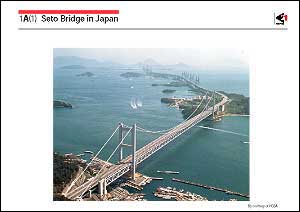Steel bridges are one of the principal
applications of steel materials. The world's first steel bridge,
named the "Iron Bridge", was an arch type built in
1779 in Coalbrookdale, which is not far from Birmingham, England,
and is known as the cradle of the coke blast furnace.
This photograph shows a modern version of steel bridges, the
Seto Bridge in Japan, which was completed in April 1988. The
complete structure is composed of three suspension bridges, two
cable-stayed bridges, four elevated bridges, and one truss bridge,
and connects mainland Honshu with Shikoku island with total bridge
length of 9,368m. The steel materials used to build the Seto
Bridge amount to 660,000 tons. Particularly significant are the
main cable wires supporting the suspension bridges, which are
made of high strength steel with a tensile strength of 1.6 gigapascals,
or four times the strength of ordinary carbon steel.
As the size of structures increases the weight of the members
also increases. For example, in the largest suspension bridge
in the Seto structure(full length: 1,723m, central span: 1,100m),
the bridge girders weigh 43,000 tons. Each of the main cables
that support the suspension bridge requires 34,417 component
wires of 5.1mm in diameter. Even when using high strength steel
wires with a tensile strength as high as 1.6 gigapascals, these
main cables have a diameter of 1.06m when stranded and a total
weight of 25,000 tons. In the latest construction of the Akashi
Bridge, even stronger steel wires with a tensile strength of
1.8 gigapascals have been employed for the main cables. Without
the development of such high tensile strength wires, construction
of the bridge was reportedly said impracticable due to the excessive
weight of the cables.
Higher strength materials make it possible to reduce the cross-sectional
area of the members needed to support a constant load, and hence
their weight. Therefore, the development of high strength materials
is extremely important. |
|

|
 |
 |
|
|